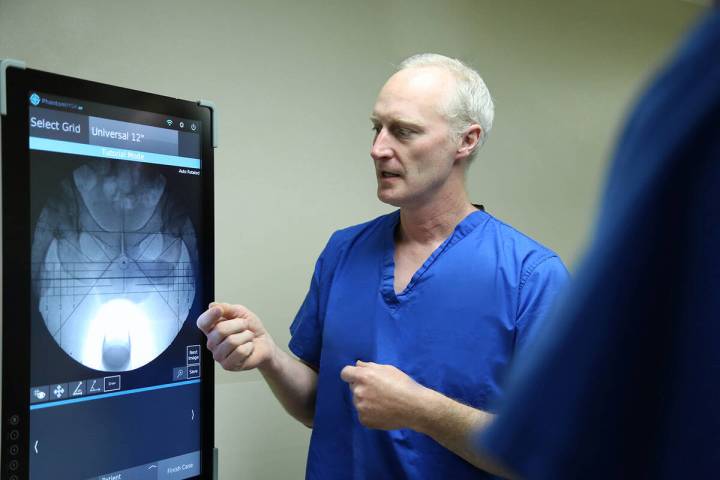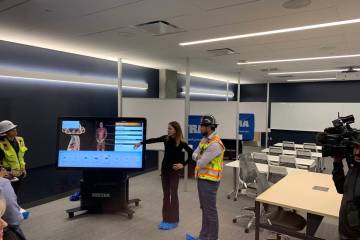Twenty years after the Las Vegas Medical District was formed, city officials formally welcomed the UNLV School of Medicine to it and touted the millions in economic impact it will generate.
The medical school starts classes July 17 and is proceeding with plans to build its campus near University Medical Center on Charleston Boulevard. The medical district that includes downtown and extends westward on Charleston Boulevard encompasses 684 acres.
During a Jan. 24 town hall celebrating the medical district, city officials touted it having $2.42 billion in economic impact by 2030, growing from $609 million by 2020. The total employment goes from 4,058 in 2020 to 16,182 in 2030. The government tax revenue is expected to be $30 million in 2020 but that jumps to $121 million in 2030.
“Since the announcement of UNLV School of Medicine (in 2014, we have seen more than 500,000 square feet of planned new development and investment of a half billion dollars into the district,” said Las Vegas Councilwoman Lois Tarkanian whose Ward 1 incorporates the medical district. “These are incredibly exciting times for the heart of our city, and we’re preparing the area for growth.”
Las Vegas City Manager Betsy Fretwell said the city’s investment has been worth it. Las Vegas spent more than $200,000 on the creation of a master plan for the district. It’s invested $36 million in the district between 2013 and 2017 on infrastructure and other improvements. An additional $97 million will be invested in 2018 and beyond, she said.
Tarkanian said she remains excited about the future prospects of the medical district and what it will do to enhance the quality of life within the valley. She said the UNLV School of Medicine will work with UMC and other medical providers to develop a coordinated center of medical excellence — something that has long been lacking in the city.
“We do have excellence in spots,” Tarkanian said. “We have some very fine doctors and medical entities, but we need to have a consistency across the board. There are some areas of need that we don’t have anybody yet.”
Beyond improving medical care, which Tarkanian said is no small feat, the Las Vegas Medical District has the potential to spur all types of development because it not only attracts doctors but other professionals who will work there and need a place to live, shop and even buy groceries, she said.
“In Ward 1 where we were slipping back on jobs, it’s revitalized that area,” Tarkanian said. “By infusing that area with more educated population and services that the neighborhood will need to support these individuals give rise to new commercial and residential development.”
Over the next 13 years, Tarkanian said that while there will be more than 16,000 permanent jobs in the medical district, there will be others that will be created because of that growth. People will need to provide services for them, she said. “When I moved here, it was just casinos. Look at how we’re moving and how fast we’re going.”
Fretwell said the goal is to make this the premier medical district in the Southwest. The original core of the district was 200 acres bounded by Charleston Boulevard, Rancho and Alta drives and Martin Luther King Boulevard. The City Council expanded it by adding 400 acres that include Symphony Park and areas along Martin Luther King and Charleston boulevards.
More than 2 million square feet have been dedicated for health care services in the area, Fretwell said.
“There’s quite a bit of room for expansion,” Fretwell said. “We’re already seeing people business taking advantage of that opportunity. We’re trying to create special districts like this for several years, and we felt this is a template for success. We’re excited about that.”
Fretwell said the city is working with the Regional Transportation Commission to have a light rail system that runs from the UNLV campus, along Maryland Boulevard and then through downtown and to the campus in the medical district.
“When you talk about a catalyst project, the medical school is a catalyst project for our city and state,” Fretwell said. “It will make us all better, and we will have a much stronger medical community and service delivery system.”
Las Vegas Mayor Carolyn Goodman said it’s impossible to be a world-class city without world-class medical care and research, and the growth of the district with the UNLV School of Medicine added will make it a place residents will stay for medical care.
“It’s the foundation of the emerging Las Vegas for high-quality medical service,” Goodman said.
Goodman sounded alarm bells, however, that the medical district’s growth and that of the region when it comes to medical care is threatened by Medicaid reimbursement rates that are lower than neighboring states. The Cleveland Clinic Lou Ruvo Center for Brain Health hasn’t expanded in recent years for the reason because doctors “have to be paid,” Goodman said. She’s lobbied lawmakers to increase the reimbursement rates that are lower than were in place in 2001, she said.
“Low Medicaid reimbursement rates affect us all, but they affect private insurers setting their rates,” Goodman said. “Doctors who have trained here may choose not to practice here because of these low reimbursement rates. This is a real problem as we go ahead and expand and build on the medical district but also work with the UNLV School of Medicine for training future doctors and continuing to attract doctors from other states. I know it’s not the only important issue before the Legislature, but it’s a matter of life and death for us all or we will be going to the airport (to go out of state for medical care).”






